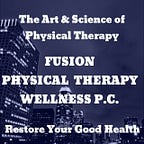Chondromalacia Patella or Patellofemoral Syndrome, What’s The Difference?
By Jeanette Calara, PT, DPT, MBA, OCS, COMT, GCFP, COS-C
Chondromalacia patella:
Chondromalacia patella is result of the softening and breakdown of the cartilage on the underside of the patella. Pain, characterize by dull, aching pain and a feeling knee grinding when the is flexed occur, is the most common symptom.
Chondromalacia patella is commonly treated with rest and ice, and little or no stair climbing at first. A supportive brace can also help lessen the pain.
People who are most at risk in developing chondromalacia patella include:the overweight, those who had an injury, fracture, or dislocation related to the kneecap, ,soccer players, runners bicyclists, and teens and healthy young adults, more often females.
Chondromalacia patella often occurs when the undersurface of the patella comes in contact with the thigh bone causing swelling and pain. Abnormal patellar positioning, tightness or weakness of the muscles associated with the knee, too much activity involving the knee, and flat feet may increase the likelihood of chondromalacia patella.
Dull, aching pain that is felt behind the patella, below the patella and on the sides of the kneecap
A feeling of grinding when the knee is flexed may occur. This can happen: knee flexed, Going down stairs, Running down hill and Standing up after sitting for awhile
Patellofemoral syndrome:
Patellofemoral syndrome often occurs with pain at the front of your knee, around your patella; often called Runners knee. it’s more common in people who participate in sports that involve running and jumping.
The knee pain often increases when you run, walk up or down stairs, sit for long periods, or squat. Simple treatments such as rest and ice often help, but sometimes physical therapy is needed to ease patellofemoral pain.
Patellofemoral syndrome usually causes a dull, aching pain in the front of your knee. This pain can be aggravated when you: Walk up or down stairs, Kneel or squat, Sit with a bent knee for long periods of time
Doctors aren’t certain of the exact cause of patellofemoral pain syndrome, but it’s been associated with: overuse, muscles around your hip and knee don’t keep your patella properly aligned, Trauma to the patella , such as a dislocation or fracture, and Knee surgery, particularly repair to the anterior cruciate ligament using your own patellar tendon.
Factors that can increase your risk include: typically affects adolescents and young adults, Women are twice as likely as men, and Participation in running and jumping sports.
Sometimes knee pain just happens. But certain steps may help prevent the pain. by: strengthening quadriceps and hip abductor muscles, losing weight, warm up with five minutes or so of light activity, gentle stretching exercises, refrain from sudden changes in the intensity of your workouts and wear shoes fit well and provide good shock absorption.
If the knee pain doesn’t improve within a few days, consult your physician.
